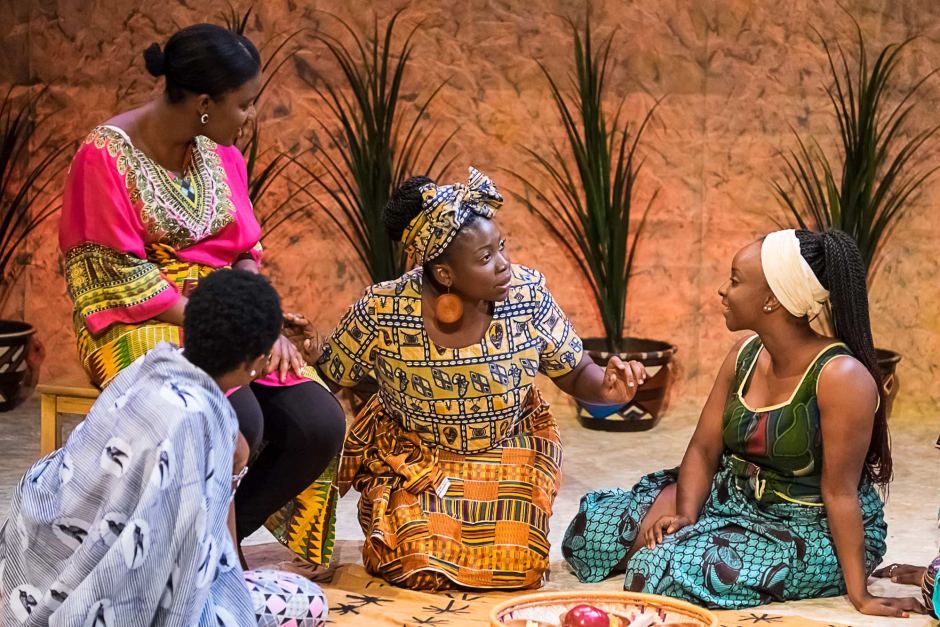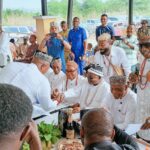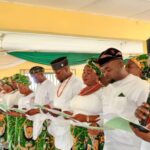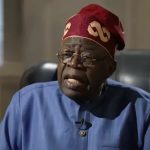Just like the theatre, African literary drama was born at the advent of literacy in Africa. In Southern Africa for example, the pioneer institution of literary drama was Zambian University, and later on, the University of Botswana. The literary drama also flourished at the Universities of Lesotho and Swaziland. South African Herbert Dhlomo, Malawian Felix Mnthali, and South African exiles Zakes Mda and Masitha Hoeane played prominent roles in the development of literary drama in southern Africa. Some of the early South African dramas include Fwanyanga Mulikita’s Shaka Zulu, Alfred Hutchinson’s The Rain Killer, Herbert Dhlomo’s Dhingana and The Girl Who Killed to Save, and Lewis Nkosi’s The Rhythm of Violence.
ALSO READ: AFRICAN DRAMA AND THE TRANSITION TO THEATRE
Julius-Adeoye reports that the history of serious literary theatre in Nigeria began with James Ene Henshaw (1924-2007) who was the first recognized playwright in Nigeria. Julius-Adeoye also affirms that literary drama was already taking root in Nigeria before the establishment of the University of Ibadan in 1948. He notes that the Onitsha market plays were flourishing and text and performances were produced between the 1940s and 1950s (50). He notes that “unlike the Nigerian Popular Theatre that was an indigenous language based, the literary theatre utilizes both English and Yoruba languages, as well as the subsequent culturally popular ‘Pidgin’ English” (50). Some of Henshaw’s plays are A Man of Character (1957), Jewel of the Shrine (1957), Companion for a Chief (1964), Children of the Goddess (1964), Magic in the Blood (1964), Medicine for Love (1964), Dinner for Promotion (1967), Enough is Enough (1975), Son to Mary Charles and Irish Sister of Charity (1980). These plays were precursors to the plays of Wole Soyinka, J.P Clark, Zulu Sofola, Ola Rotimi, and others.
The literary tradition saw the birth of plays such as Soyinka’s Jero’s Metamorphosis, A Dance of the Forests, Kongi’s Harvest, Madmen and Specialists, The Strong Breed, The Road, Death, and the King’s Horseman, etc. J.P Clark’s Ozidi, Song of a Goat, The Raft, etc. are also worthy of note.
Indeed, many playwrights have traversed the dramatic landscape of Africa. In southern Africa, the likes of Herbert Dhlomo, Lewis Nkosi, Athol Fugard, Zakes Mda, Fwanyanga Mulikita, and Alfred Hutchinson, used literary drama to fight colonization and apartheid. Some of the early South African dramas include Fwanyanga Mulikita’s Shaka Zulu, Alfred Hutchinson’s The Rain Killer, Herbert Dhlomo’s Dhingana and The Girl Who Killed to Save, and Lewis Nkosi’s The Rhythm of Violence. These plays try to recreate history from the time of Shaka through the coming of the white man to South Africa. For example, we see that Mulikita traces the rise and fall of the emperor Shaka in Shaka Zulu. Just like Thomas Mofolo’s adaptation of the same legendary story, Mulikita dramatizes the treachery that leads to the demise of Shaka. It is in this relation that Herbert Dhlomo’s Dhingana uses the metaphor of darkness to symbolize the fall of the Zulu kingdom. As Ibitoye puts it, the death of Shaka marks the beginning of contact with the white man which eventually culminates in the domination of the whites over the blacks in South Africa. Accordingly, Hutchinson’s The Rain Killers calls attention to the presence of Europeans in South Africa. Essentially, the play dramatizes the friction between Christianity and traditional religion, modernity, and traditionalism.
Protest and resistance are inextricable phenomena in South African written drama. Luren Kruger (1999) observes that southern African drama is conventionally associated with the anti-apartheid movement, identified with “protest” and “resistance,” and with the names of Athol Fugard, John Kani, or Barney Simon. Wally Serote also posits that “plays written by black playwriters [sic], are quite explicit in expressing the aspirations of the Africans, and the voice of protest is their common denominator”. Athol Fugard, a white South African, is a prolific dramatist. His plays are most of the significant plays from South Africa. Most of his works dwell on the theme of racism in South Africa. His subject matter revolves around the lives of commoners and apartheid. Lewis Nkosi is one of South Africa’s black writers whose literary works were banned under the Suppression of Communism Act. He faced many restrictions in his literary enterprise. Consequently, he went into exile in the United States of America. In Nkosi’s Rhythm of Violence, we encounter a very radical kind of protest which is not suppressed.
In East Africa, Ngugi Wa Thiongo, Francis Imbuga, John Ruganda, Austin Bukenya, Thomas Akare, and others have also exploited the dramatic genre in their search for national identity. Ngugi’s The Trial of Dedan Kimathi is a historical play that traces the events of the Mau Mau uprising. Apart from Soyinka, Clark, and others earlier mentioned, West Africa has also churned out many playwrights including Efua Sutherland, Ama Ata Aidoo, Joe de Graft, Ahmed Yerima, Femi Osofisan, Tess Onwueme, and many others. E.K Ogunmola stands as one of Africa’s dramatists who began the move of drama from written text to theatre. According to Ebun Clark, Ogunmola’s stay at the University of Ibadan resulted in the production of Amos Tutuola’s The Palmwine Drinkard on stage.
We shall, here, undertake a brief excursion through the evolution of feature film in Nigeria, which according to Afolabi Adesanya is similar to that in any other African country. Julius-Adeoye submits that the introduction of television into Nigeria in 1959 by Obafemi Awolowo enabled the practitioners of Yoruba popular theatre to reach out to a wider audience, with the Western Nigerian Television providing an avenue for studio performance for the likes of Ogunde and Duro Ladipo. As stated by Ogundele, although television was there at the height of the traveling theatre’s career, it neither attained social centricity nor was a serious rival as a new alternative medium by which the popular Yoruba theatre could reach its urban audience. But by the late 1970s and early 1980s television was a strong alternative and parallel medium that dramatists like Ogunde and Duro Ladipo used alternatively or in combination. So, by the end of the 1980s, video plays had become the dominant technological medium of popular culture and entertainment. Jonathan Haynes and Onookome Okome have stated that the work of the artists from the Yoruba traveling theatre tradition accounts for the strongest element in the twenty years of Nigerian celluloid film production. But apart from Western Nigeria, by the 1960s theatre troupes all over Nigeria had begun to maximize the medium. Hence, Popular dramas like “The Village Headmaster”, “The New Masquerade”, “Sura the Tailor”, “Koko Close”, “Mirror in the Sun”, Mind Benders”, “Samanja” and “Jagua” were produced in either standard English or Nigerian Pidgin English or a blend of both.
Though the film was first used in both the Southern and Northern Protectorates in 1903 by the British colonialists, it was not until the 1970s that Nigerians made their first feature film, with Wole Soyinka’s Kongi’s Harvest as the first Nigerian feature film, followed by Duro Ladipo’s Ajani Ogun as the first Yoruba feature film. The advancement of audio-visual technology in the 1980s paved the way for the production of Nigerian video films. Consequently, stage performances and the cinema culture disappeared to make room for the new video-film format which characterized the whole of the 1990s and up to the present. Kenneth Nnebue’s Living in Bondage also gave a great boost to video film. According to Haynes and Okome Igbo video production, launched in 1992 with Living in Bondage later saw the emergence of many other films such as Checkmate, Violated I and II, Rattlesnake, Adamma, etc.
Hausa video films also flourished in northern Nigeria. Haynes and Okome have noted the adaptation of the Hausa pamphlet romances into video film. An example of this trend is Soyaya Kunar Zuci, produced by the Nigerian Film Corporation. By the beginning of the twenty-first century, video film had established a visible and monumental presence in Africa, with the Nigerian video-film industry colloquially called Nollywood regarded as the third-largest motion picture industry in the world, producing at least two hundred movies every month as of 2005. Nollywood had thus become the paradigm for video film in Africa.








